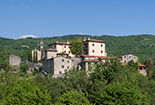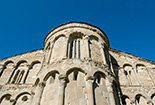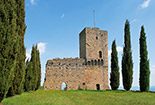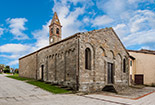The Church of Saint Antonio in Socana
in Casentino, a Tuscan valley with which you can get familiar in every detail through this site
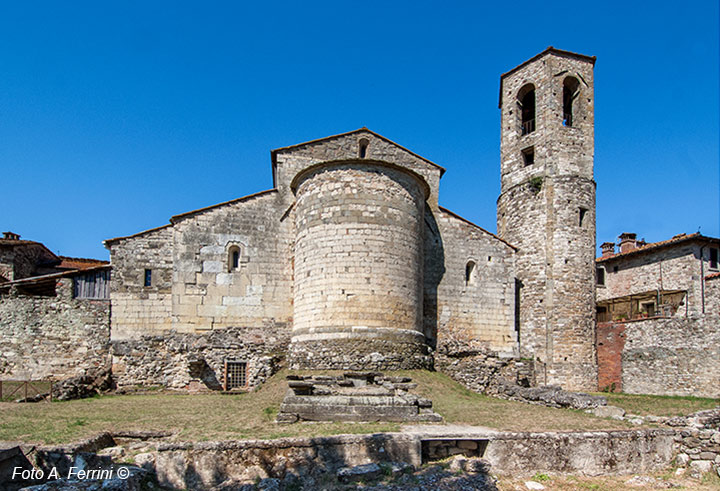
Texts and photos by Alessandro Ferrini ©
36 accurately described images of Pieve of Socana. Click to enlarge
The Parish Church of Socana, a story that began 2500 years ago
 For centuries it has been narrated a legend that spoke about an important Etruscan place of worship located where nowadays the Romanesque Parish Church of Socana in Casentino is situated.
For centuries it has been narrated a legend that spoke about an important Etruscan place of worship located where nowadays the Romanesque Parish Church of Socana in Casentino is situated.
At the beginning of the 1970s, the Government Cultural Assets Department of Arezzo promoted an excavation campaign in several churches of its province. In Socana, while digging behind the church at a few meters away from its apsis, an archaeological find of extraordinary importance and beauty came to light: a great Etruscan altar dating back to the 5th century before Christ. Near this altar there had to be a temple: as a matter of fact, its remains were found under the church. A part of the staircase that went up to the sacred building is nowadays visible behind a grating put on the left side of the apsis. The centuries-old legend had become historical truth.
The presence of a temple in this area has two explainations: Socana, these days in the Municipality of Castel Focognano, used to be an important road knot in Etruscan times, where routes that led to Arezzo, the Valdarno and the high Casentino crossed. The second reason is that a few hundred meters away from Socana there is the village of Rassina, a relatively modern inhabited center, but with a very ancient  toponym that comes from "Rasenna", a word with which the Etruscans used to define themselves. If these people had given their own name to a place, it meant that they believed it was particularly important and, therefore, it deserved a sacred place as this temple, which was preserved from the 5th to the 2nd century before Christ.
toponym that comes from "Rasenna", a word with which the Etruscans used to define themselves. If these people had given their own name to a place, it meant that they believed it was particularly important and, therefore, it deserved a sacred place as this temple, which was preserved from the 5th to the 2nd century before Christ.
After the Etruscan years, for Socana it arrived the Roman time dating back from the 2nd century BC to the 6th century AC. During this period the pieces of informaton regarding this place are almost non-existent. It surely remained a road knot due to the presence of the Romans in Casentino, but with a minor importance than before because of the fact that from Arezzo the Romans had built the Cassia Vetus in the Valdarno for going north, while they travelled through the Tevere valley for going in Romagna.
The recovery of Socana from the spiritual, commercial and logistic point of view can be dated back to the 9th century with the first important Christian evidence in this place: the edification of a small church, corresponding to what nowadays is the right aisle of the current parish church.
This place was gaining importance under several aspects: proof of this is the edification, at the end of the 10th century, of a great church with three naves and three apses, as large as the present church, but almost twice as long (some bases of the columns of this building are nowadays clearly visible within the church, as well as the exterior remains of the two lateral apses).
In the 12th century the current Romanesque parish church was built with the same dimensions of the previous church, the partition columns of the three naves were replaced by strong pillars that were used to support six large round spans. Out of the three apses, only the central one remained.  The Romanesque parish church of Socana was short-lived in this majestic aspect. As a matter of fact, in the 15th century the first three spans were demolished and the facade was rebuilt in line with the end of the third span. Nowadays, the plan of the church is almost square. The capitals on top of the pillars have a flat shape and the simple representations that were there sculpted are at this point indecipherable. The architecture of the bell tower is very particular: it has a cylindrical shape in the lower part, while an hexagonal one in the upper part.
The Romanesque parish church of Socana was short-lived in this majestic aspect. As a matter of fact, in the 15th century the first three spans were demolished and the facade was rebuilt in line with the end of the third span. Nowadays, the plan of the church is almost square. The capitals on top of the pillars have a flat shape and the simple representations that were there sculpted are at this point indecipherable. The architecture of the bell tower is very particular: it has a cylindrical shape in the lower part, while an hexagonal one in the upper part.
The Parish Church of Saint Anthony in Socana could be defined "artistically poor" compared to the parish churches of the High Casentino. It probably did not have nobles or wealthy families that financed it; in addition, its workers were surely locals and not the skilled ones form Lombardia. But, if we stand between the apse and the Etruscan altar and we leave our imagination free, we will see next to us architectures such unusual as fascinating, all this enveloped in a large halo of mistery. In all the Casentino, this is a feeling that maybe only the Parish Church of Socana can convey us.
The timetable for visiting inside the Parish Church of Socana are:
From Monday to Saturday, from 8.00 to 12.00 - from 16.00 to 19.30
On Sundays from 9.00 to 12.00 - from 15.00 to 19.30
For info: +39.333.9631188 - Ilaria
Accessing to the archaeological area for tourist visits is possible in every moment, every day. In order to enter, we pass throught a gate next to the rectory or throught the small playground placed a little farther.



